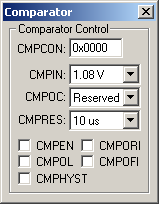|
||
| Products Download Events Support Videos | ||
Product Information
Device Database®
Downloads
Compliance Testing
Distributors
Peripheral Simulation
For Analog Devices ADuC7027 — Comparator
Simulation support for this peripheral or feature is comprised of:
- Dialog boxes which display and allow you to change peripheral configuration.
These simulation capabilities are described below.
Comparator Dialog

The Comparator Dialog controls simulation of the uncommitted voltage comparator of the ADuC7000 series devices. When enabled, it allows the user to compare ADC2 voltage to the other voltages (DAC output, internal or ADC3) to generate a logic-level signal to a variety of destinations.
Comparator Control Group
- CMPCON (Comparator Control Register) contains the following control settings:
- CMPIN (Comparator Negative Input) selects the negative input signal to be compared against ADC2.
- CMPOC (Comparator Output Configuration) selects the how and where the output of the comparator should be applied.
- CMPRES (Response Time) selects the comparator response time from 0.5µs to 10µs.
- CMPEN (Comparator Enable) is set to enable the comparator.
- CMPOL (Comparator Output Logic State) is set to produce a high logic level when ADC2 is less than the negative input signal selected in CMPIN.
- CMPORI (Comparator Output Rising Edge Interrupt) is set when a rising-edge occurs on ADC2. This must be cleared by software.
- CMPOFI (Comparator Output Falling Edge Interrupt) is set when a falling-edge occurs on ADC2. This must be cleared by software.
- CMPHYST (Comparator Hysteresis) is set to allow approximately 7.5mV of hysteresis. If reset, no hysteresis is assumed.
Voltage Reference Group
- VREF is the on-chip, 2.5 volt internal voltage reference.
DAC Reference Group
- DACREF is the external voltage reference for the DAC. The DAC Controller may select this reference.
ADC Reference Group
- AVDD (Analog Power) is the 3.3 volt analog power.
ProductsDevelopment Tools |
Hardware & Collateral |
Downloads |
Support |
Contact |
